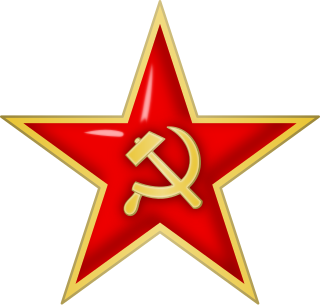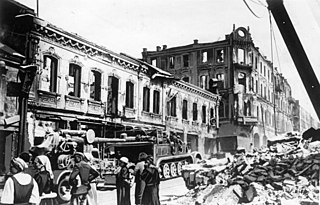The Southern Front was a front, a formation about the size of an army group of the Soviet Army during the Second World War. The Southern Front directed military operations during the Soviet occupation of Bessarabia and Northern Bukovina in 1940 and then was formed twice after the June 1941 invasion by Germany, codenamed Operation Barbarossa.

The Western Front was a front of the Red Army, one of the Red Army Fronts during World War II.

The Battle of Velikiye Luki, also named Velikiye Luki offensive operation, started with the attack by the forces of the Red Army's Kalinin Front against the Wehrmacht's 3rd Panzer Army during the Winter Campaign of 1942–1943 with the objective of liberating the Russian city of Velikiye Luki as a previous part of the northern pincer of the Rzhev-Sychevka Strategic Offensive Operation.
The 4th Mechanized Corps was a formation in the Soviet Red Army during the Second World War.

The Battle of Białystok–Minsk was a German strategic operation conducted by the Wehrmacht's Army Group Centre under Field Marshal Fedor von Bock during the penetration of the Soviet border region in the opening stage of Operation Barbarossa, lasting from 22 June to 9 July 1941.
A mechanised corps was a Soviet armoured formation used prior to the beginning of World War II and reintroduced during the war, in 1942.
The 16th Army was a Soviet field army active from 1940 to 1945.

Alexander Ilyich Lizyukov was a Soviet military leader holding the rank of major-general. He was awarded the title of Hero of the Soviet Union on 5 August 1941.
The 1st Mechanized Corps was a mechanized corps of the Red Army during World War II that formed twice.
The 5th Guards Zimovnikovskaya order Kutuzov II degree Motor Rifle Division, named on the 60th anniversary of the USSR, was a military formation of the Soviet Ground Forces. It was formed from the 6th Mechanized Corps created in 1940 and destroyed in 1941 in the beginning of Operation Barbarossa. The corps was reformed in November 1942 under the same name, but with a different organizational structure. In January 1943, the 6th Mechanized Corps was granted "Guards" status and became the 5th Guards Mechanized Corps.
The 11th Tank Division was a Soviet tank division initially formed in 1940 at Tiraspol and destroyed in 1941; it was then formed as a tank corps in May 1942. This unit was subsequently reorganized as the second formation of the 11th Tank Division in 1945.
The 300th Rifle Division began service as a standard Red Army rifle division shortly after the German invasion, and fought in the southwestern part of the Soviet-German front for nearly two years following. It was able to escape the encirclement east of Kiev in September, 1941, and then fought to defend, and later to try to liberate, the city of Kharkov during 1941-42. After falling back under the weight of the German 1942 summer offensive, the division began distinguish itself during Operation Uranus in late 1942, when it helped defeat the German attempt to relieve Sixth Army and later in the pursuit of the defeated Axis forces and the second liberation of Rostov-na-Donu. In recognition of these successes it was raised to Guards status as the 87th Guards Rifle Division. A second 300th Rifle Division was raised a few months later and fought briefly but very successfully against the Japanese in Manchuria in August 1945. The second formation became the 3rd Tank Division in the Far East postwar and was redesignated as the 46th Tank Division in 1957 before disbanding in 1959.
The 37th Guards Rechitsa, twice Red Banner, Orders of Suvorov, Kutuzov, and Bogdan Khmelnitsky Rifle Division was an infantry division of the Red Army which fought during World War II.
Viktor Grigoryevich Zholudev was a Red Army major general and posthumous Hero of the Soviet Union. Zholudev fought in the 1929 Sino-Soviet conflict, the Battle of Lake Khasan in 1938 and the 1939 Battles of Khalkhin Gol, as well as World War II. Zholudev commanded the 37th Guards Rifle Division during its defense of the Stalingrad tractor factory during the Battle of Stalingrad.

Mikhail Petrovich Petrov was a Red Army major general and a Hero of the Soviet Union. Born to a peasant family, he moved to Petrograd and became a metalworker at the Putilov Plant, where he became a Red Guard squad leader and fought in the storming of the Winter Palace. He joined the Red Army and fought in the Russian Civil War. During the interwar period Petrov became an armored corps officer and fought as a tank battalion commander during the Spanish Civil War. For his leadership, he received the title Hero of the Soviet Union on 21 June 1937.
The 321st Rifle Division was formed in September 1941, as a standard Red Army rifle division, based on an existing division of militia. This formation had an extremely short career, coming under devastating attack in the north of the Crimea on the day of its redesignation and being officially disbanded just over a month later. A second division began forming in the Transbaikal in February 1942, and served in the defensive and offensive fighting around Stalingrad, eventually distinguishing itself sufficiently to be redesignated as the 82nd Guards Rifle Division. The world had not seen the last of the 321st, however, as a new division was formed from two existing rifle brigades in the spring of 1944, which gave very creditable service for the duration, completing its combat path in northeastern Germany, and serving into the postwar period.

The Battle of Nevel was a successful military operation conducted by the Red Army in the Pskov Oblast of western Russia and in northern Belarus during World War II, from October 6 to roughly December 16, 1943, although fighting persisted in the area into the new year.
The 204th Rifle Division was twice formed as an infantry division of the Red Army after a motorized division of that same number was destroyed in the first weeks of the German invasion of the Soviet Union. The first formation was based on the shtat of July 29, 1941, and it then remained for nine months in the far east of Siberia training and organizing before it was finally sent by rail to the Stalingrad region in July 1942 where it joined the 64th Army southwest of the city. During the following months it took part in the defensive battles and later the offensive that cut off the German 6th Army in November. In the last days of the battle for the city it took the surrender of the remnants of a Romanian infantry division. Following the Axis defeat the division was recognized for its role when it was redesignated as the 78th Guards Rifle Division on March 1, 1943.
The 219th Rifle Division was formed as an infantry division of the Red Army after a motorized division of that same number was redesignated about 10 weeks after the start of the German invasion of the Soviet Union. Due to a chronic lack of vehicles, and especially tanks, the division had been effectively serving as a motorized rifle brigade since June 22, so the redesignation was a formality and it was soon destroyed in the encirclement battle east of Kiev.
The 28th Tank Division was an armored division of the Red Army, created during the prewar buildup of forces in the Baltic Special Military District, based on a light tank brigade and a motorized rifle brigade, and fought against German Army Group North during the first months of Operation Barbarossa. It was initially under command of the 12th Mechanized Corps of 8th Army. It was noteworthy for being the first wartime command of Ivan Chernyakhovskii, who went on to lead the 3rd Belorussian Front. The division's tank regiments were largely destroyed in the first battles, but not without inflicting losses themselves, after which the remnants fell back through Latvia and Estonia, receiving enough reinforcements and replacements to remain combat-effective. It served well at Novgorod and in the early fighting around Demyansk, as part of 27th Army, but in November the Stavka ordered it to be converted to the 241st Rifle Division.






